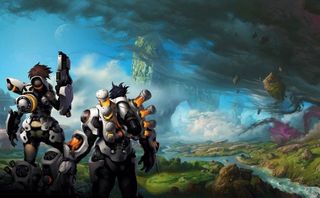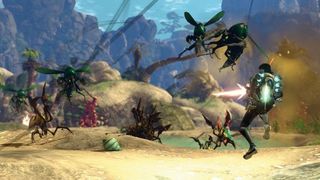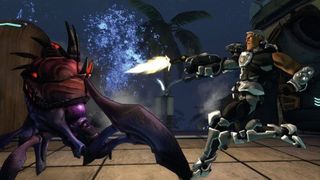Firefall preview: taking to the skies in Red 5's ambitious open world MMO

This article originally appeared in issue 247 of PC Gamer UK.
On the first day I visit Red 5 Studios, the lifts are behaving oddly. They take an age to arrive, and stay at empty floors too long. James Macauley, vice president of development, tells me this is a common thing. Sometimes they break down with people inside them.
Later that day, James references the idea of the 'elevator pitch' – a spiel designed to sum up a project in a brief lift ride. He tries the Firefall elevator pitch out on me. “We're a shooter, we're an online shooter, we're a social game, we're an MMO, we're an RPG, we're an RTS. There's a massively persistent open world, deep character progression, deep backstory and lore, competitive PvP and e-sports-focused match types, ladders and leagues. We have all these different aspects of different games, we have the social features of MMOs, we have armies – built-in clan support much like a guild – we have all of this stuff and it's a free-to-play game.”
James smiles, aware of the difficulty of describing his MMO. “The elevator ride is done by the time you can say what the game is.” Even in Red 5's ambling elevators, Firefall is not an easy game to explain.

At the end of my interview, James flips it around and asks me to describe Firefall in a few words. I could try to explain what I've been shown, say that it's an MMO set on a future Earth under attack by everything from monster bugs to the pseudo-human Chosen, that it plays more like a shooter thanks to class choices and snappy, tactile combat. But then I would fall into the same, wordy trap. I mutter something about jetpacks and shooting.
It's a reductionist view, to define Firefall by its airbound combat, but for a game as huge as this, it's a good place to start – particularly when James and Scott Youngblood – Firefall's lead designer – class the game as an 'MMO shooter'.
The arrangement of the words in my description is wrong though: for James and co, the shooting had to come first.
PC Gamer Newsletter
Sign up to get the best content of the week, and great gaming deals, as picked by the editors.
“We have a test called the wall test. It should feel good to pick up a gun and shoot a wall. And once – and only once – it feels good to shoot a wall, then we look at making it feel good to shoot a player or shoot a creature.”

But as with the elevator pitch, it wasn't simple. Firefall takes place in an MMO world, and very few MMOs manage the kind of kinetic feedback Red 5 were chasing. “I can't think of a more complex system,” James tells me. “You have all these calculations. A bullet flying through the air could collide with any number of hundreds of players on that server at one time.”
But impressively, they've managed it: firing one of Firefall's guns feels like firing a gun in a singleplayer action game. It's infinitely more satisfying than the kind of behind-the-scenes dice rolls MMOs traditionally employ. James puts this satisfaction down to the game's lengthy beta test. The developers, he argues, were unafraid to go in and rejig entire elements of the game as the community provided feedback.
The beta – running for much of 2012 – heavily influenced the game's development. James constantly references design decisions as originating from what he describes as “the most amazing community of any game ever, period.”
Nothing was given a free pass. “We questioned everything down to movement speed. That's typically a sacred cow. Once you decide movement speed, all of the level designers, all of the artists, the rest of the team can start building a world based on that speed. Timing is so critical in an action shooter. But we decided that we'd rather have the extra work going back and modifying our existing levels, than to try to jury-rig fun into what we already had. So we made the call and we increased movement speed by 20 percent. We also increased jump height, we changed how gravity affects falling so you're a little bit more floaty, and we changed jumpjets completely, giving you a lot more burn time.”
Most Popular





